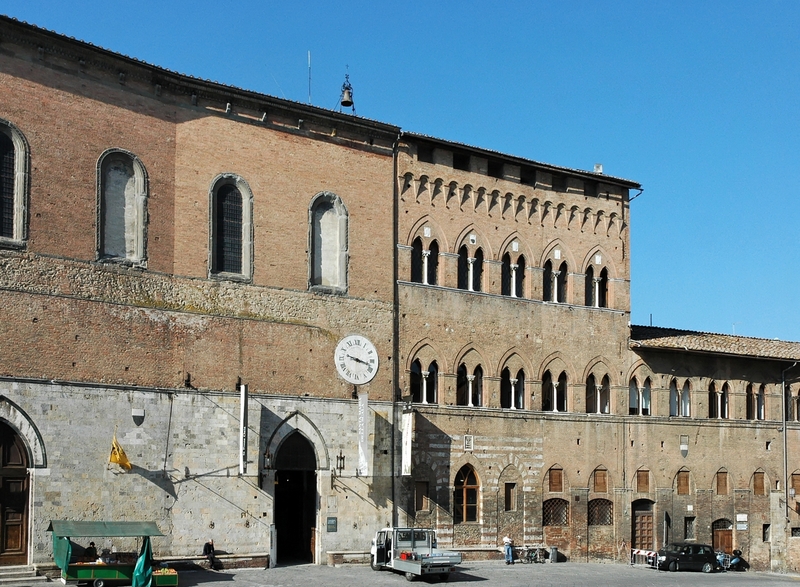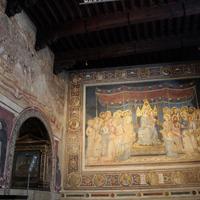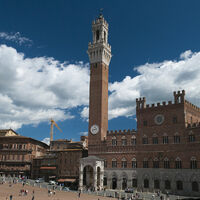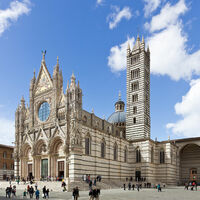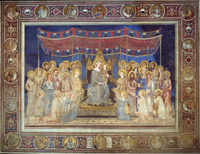Virgin Mary in Siena
Type:
Altarpieces,
Cities,
Wall paintings
Date:
Fourteenth century
Location or Findspot (Modern-Day Country):
Italy
Dimensions:
Simone Martini, Maestà, 7.6 × 9.7 m
Description:
By the fourteenth century Siena's banks and merchants had brought it great wealth, and it rivaled Florence as an economic and cultural center. Major artists were commissioned to adorn the city's cathedral and public buildings with works in honor of the Virgin Mary, who was considered the city's protector. These included Duccio di Buoninsegna, who executed an enormous altarpiece in the cathedral known as the Maestà ("Majesty"; begun 1308), and Simone Martini, who painted (with his brother-in-law) a gilded altarpiece depicting the Annunciation for one of its chapels (1333).
In Siena's town hall, the Palazzo Pubblico, Simone's own Maestà may be the artist's earliest work (1315; retouched by him in 1321). The large fresco dominates the room where the nine members of the city council deliberated. The queenly Virgin and Child are shown enthroned beneath a baldachin held aloft by a crowd of angels and saints. In this three-dimensional setting, the four Sienese patron saints solicit Mary's continued favor for the city. In the frame, prophets and saints in medallions alternate with the city's insignia. The Italian inscription at the bottom says, "Siena had me painted by the hand of Simone."
On the steps of Mary's throne, lines composed in terza rima—a poetic meter created by Dante Alighieri for his Divine Comedy—explain the fresco. The Virgin addresses the Council of Nine directly, urging them to lead according to moral and religious principles that will ensure justice and harmony. She condemns the factions in the city that threaten its harmony and security. Thus, in a room at the heart of Siena, Mary is present among the city councillors, and her wise words are given in the vernacular for maximum effect.
The Sienese government also controlled the cathedral and the hospital adjacent to it, both dedicated to Mary. After the hospital acquired a collection of Byzantine relics in 1359 (including Passion relics and the veil, cap, and belt of the Virgin), they were displayed publicly on the feast of the Annunciation (25 March). This became a major liturgical and civic event. In this way, the small, personal relics were reinterpreted as public symbols of Siena and marks of Mary's favor.
In Siena's town hall, the Palazzo Pubblico, Simone's own Maestà may be the artist's earliest work (1315; retouched by him in 1321). The large fresco dominates the room where the nine members of the city council deliberated. The queenly Virgin and Child are shown enthroned beneath a baldachin held aloft by a crowd of angels and saints. In this three-dimensional setting, the four Sienese patron saints solicit Mary's continued favor for the city. In the frame, prophets and saints in medallions alternate with the city's insignia. The Italian inscription at the bottom says, "Siena had me painted by the hand of Simone."
On the steps of Mary's throne, lines composed in terza rima—a poetic meter created by Dante Alighieri for his Divine Comedy—explain the fresco. The Virgin addresses the Council of Nine directly, urging them to lead according to moral and religious principles that will ensure justice and harmony. She condemns the factions in the city that threaten its harmony and security. Thus, in a room at the heart of Siena, Mary is present among the city councillors, and her wise words are given in the vernacular for maximum effect.
The Sienese government also controlled the cathedral and the hospital adjacent to it, both dedicated to Mary. After the hospital acquired a collection of Byzantine relics in 1359 (including Passion relics and the veil, cap, and belt of the Virgin), they were displayed publicly on the feast of the Annunciation (25 March). This became a major liturgical and civic event. In this way, the small, personal relics were reinterpreted as public symbols of Siena and marks of Mary's favor.
Relevant Textbook Chapter(s):
9,
10
Image Credits:
Wikimedia Commons
